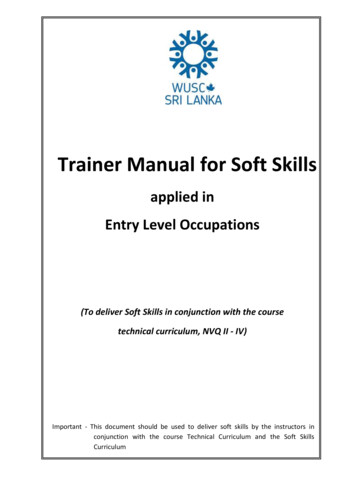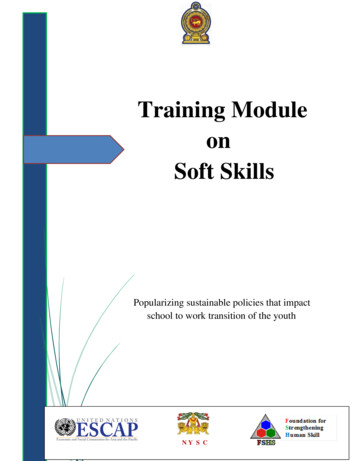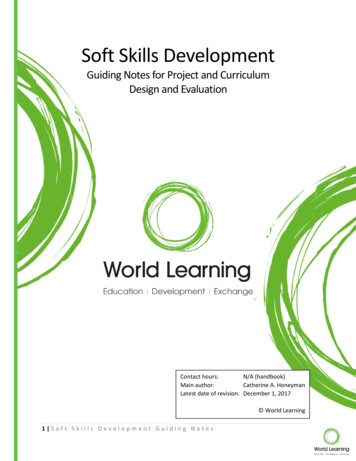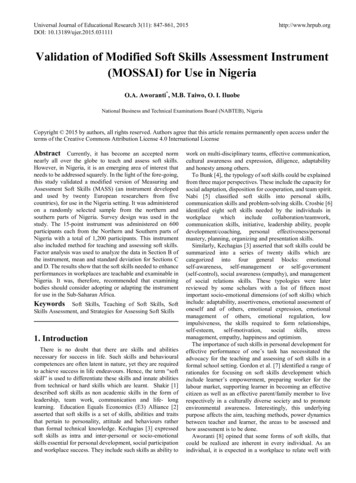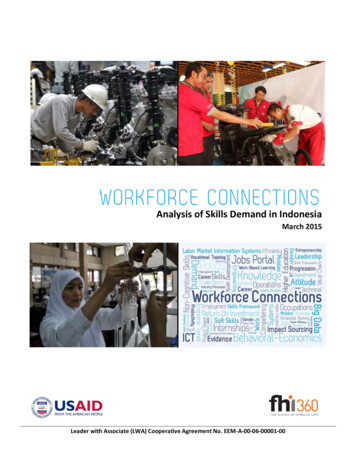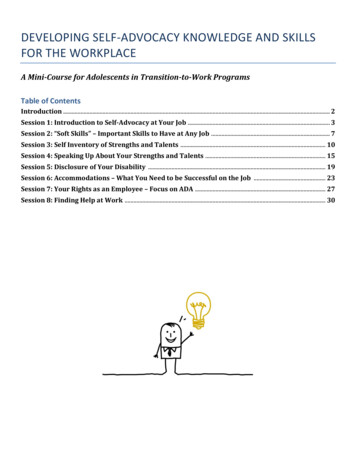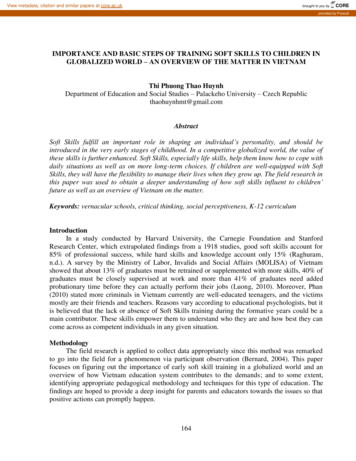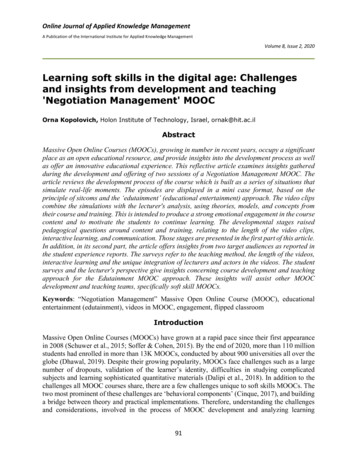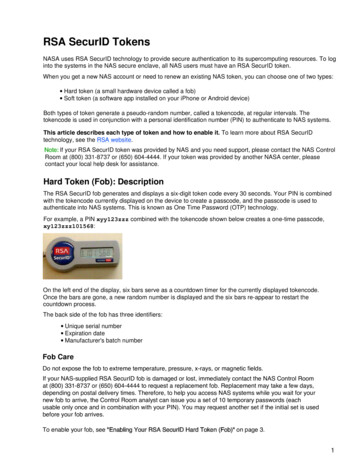
Transcription
10 Soft Skills You NeedParticipant GuideColumbus Technical CollegeEconomic DevelopmentCorporate Training Materials
TABLE OF CONTENTSModule One: Getting Started .7Workshop Objectives . 7Module Two: What are Soft Skills? .8Definition of Soft Skills . 8Empathy and the Emotional Intelligence Quotient . 9Professionalism . 9Learned vs. Inborn Traits . 10Case Study. 10Module Two: Review Questions. 11Module Three: Communication .13Ways We Communicate. 13Improving Nonverbal Communication. 14Listening. 14Openness and Honesty . 15Case Study. 15Module Three: Review Questions . 16Module Four: Teamwork .18Identifying Capabilities . 18Get Into Your Role . 19Learn the Whole Process . 19The Power of Flow . 20Case Study. 20Module Four: Review Questions . 21
Module Five: Problem-Solving .23Define the Problem . 23Generate Alternative Solutions . 24Evaluate the Plans . 24Implementation and Re-Evaluation . 24Case Study. 25Module Five: Review Questions . 26Module Six: Time Management .28The Art of Scheduling . 28Prioritizing. 29Managing Distractions . 29The Multitasking Myth . 30Case Study. 30Module Six: Review Questions . 31Module Seven: Attitude and Work Ethic .33What Are You Working For? . 33Caring for Others vs Caring for Self . 33Building Trust . 34Work Is Its Own Reward . 34Case Study. 35Module Seven: Review Questions . 36Module Eight: Adaptability/Flexibility .38Getting Over the Good Old Days Syndrome . 38Changing to Manage Process . 39Changing to Manage People . 39Showing You’re Worth Your Weight in Adaptability . 39
Case Study. 40Module Eight: Review Questions . 41Module Nine: Self-Confidence (Owning It) .43Confident Traits . 43Self-Questionnaire . 44Surefire Self-Confidence Building Tactics . 44Build Up Others . 45Case Study. 45Module Nine: Review Questions . 46Module Ten: Ability to Learn .48Wow, You Mean I’m Not Perfect? . 48Listen with an Open Mind . 49Analyze and Learn. 49Clear the Air and Don’t Hold Any Grudges . 49Case Study. 50Module Ten: Review Questions . 51Module Eleven: Networking .53Redefine Need. 53Identifying Others’ Interests . 54Reach Out . 54When to Back Off . 54Case Study. 55Module Eleven: Review Questions . 56Module Twelve: Wrapping Up .58Words from the Wise . 58
Skill to do comes of doing.Ralph Waldo EmersonModule One: Getting StartedHaving the technical skills and knowledge to successfully execute your job duties is only one part ofbeing the best you can be in the workplace. In addition to these “hard” skills, we also need “soft” skills.Soft skills are those skills which allow us to effectively work with others. No matter what your position,organization, or industry, you work with people! Taking the time to build effective soft skills cancontribute to a more efficient, more harmonious, and more productive workplace, as well as to yourown overall job happiness and satisfaction.Workshop ObjectivesResearch has consistently demonstrated that when clear goals are associated withlearning, it occurs more easily and rapidly. With that in mind, let’s review our goalsfor today.At the end of this workshop, participants should be able to: Discuss how soft skills are important to success in the workplace Understand the 10 key soft skills everyone should have Use soft skills to relate more effectively to others in the workplace Understand how to use soft skills to communicate, problem-solve, and resolve conflict Apply soft skills to specific situationsPage 7
I think we all have empathy. We may nothave the courage to display it.Maya AngelouModule Two: What are Soft Skills?What are soft skills, anyway? Simply put, soft skills are the personalattributes that allows us to effectively relate to others. These skillsenhance our personal interactions and lead to greater jobperformance and satisfaction. Unlike hard skills, which are thetechnical and knowledge skill set we bring to our work, soft skills areinterpersonal and can be applied in a broad array of situations. Softskills encompass both personality traits, such as optimism, andabilities which can be practiced, such as empathy. Like all skills, softskills can be learned.Definition of Soft SkillsSoft skills are personal attributes that allow us to effectively relate toothers. Applying these skills helps us build stronger workrelationships, work more productively, and maximize our careerprospects. Often we place the focus of our career developmentefforts on hard skills – technology skills, knowledge, and other skillsthat specifically relate to our ability to get work-related tasks done. This means we neglect to developour soft skills. However, soft skills are directly transferrable to any job, organization, or industry. As aresult, they are an investment worth making.Soft skills include: Page 8CommunicationListeningShowing EmpathyNetworkingSelf-confidenceGiving and receiving feedback
Empathy and the Emotional Intelligence QuotientEmpathy is perhaps the most important soft skill we can develop for betterinterpersonal interactions. Empathy is the ability to identify with another person’sexperience. While we often think of empathy in terms only of identifying withsomeone’s pain or negative experience, we can apply empathy in a variety ofsituations. Developing empathy allows us to imagine ourselves in another person’sshoes, to respond to others, and even to vicariously experience others’ feelings ofemotions. When we demonstrate empathy, we create connections with others, which can help to buildteamwork or otherwise create shared goals. Empathy also helps to forge stronger interpersonalconnections between team members and colleagues, which is as important as shared goals orcomplementary skills when it comes to accomplishing work.Empathy is one component of what is known as Emotional Intelligence, or EI. Emotional Intelligence isthe ability to recognize and manage our feelings so that they are expressed appropriately. Exercisingemotional intelligence helps to create harmonious, productive relationships. There are four keycomponents to Emotional Intelligence: Self-awareness: The ability to recognize our own feelings and motivationsSelf-management: The ability to appropriate express (or not express) feelingsSocial awareness: Our ability to recognize the feelings and needs of others, and the norms of agiven situationRelationship management: Our ability to relate effectively to othersTaken together, these skills make up our Emotional Intelligence Quotient (EQI). The EQI is a measure ofyour ability to exercise soft skills such as empathy.ProfessionalismThe word “professionalism” often conjures up images of a cold, distant, brusqueperson in a nondescript navy blue suit. In fact, many people have the sense thatto be “professional” is exactly the opposite of demonstrating empathy andemotional intelligence! However, professionalism is a key soft skill, and it doesn’trequire you to be inauthentic, distant, or detached. Professionalism is simply theability to conduct yourself with responsibility, integrity, accountability, and excellence. Acting withprofessionalism also means seeking to communicate effectively with others and finding a way to beproductive. Professionalism involves what may seem to be small acts, such: Page 9Always reporting to work on time and returning promptly from breaksDressing appropriatelyBeing clean and neatSpeaking clearly and politely to colleagues, customers, and clients
Striving to meet high standards for one’s own workLearned vs. Inborn TraitsBecause soft skills are talked about as traits of a person’s personality, it may seem asthough you have to born with them. While some soft skills come more easily to oneperson than they might to another, soft skills are not inborn. Like all skills, they can belearned. Because we all have our own preferences and ways of moving through theworld, some soft skills may be more difficult to learn than others. But if we think back,there are also aspects of our hard skill set that were difficult at first, though they now seem to comequite naturally to us. We develop soft skills in the same way we develop hard skills – we practice!Spending time with people who seem to be able to effortlessly demonstrate a soft skill that you findchallenging is one way to build your soft skill set. Another way is to seek opportunities to practice inwhich the risk of failure is low, until you feel confident in your ability. You don’t have to be born anetworker or an empathetic person – you can learn and build these skills throughout your career.Case StudyDee was just not a “people person.” She preferred to work by herself,and her position at her company allowed her to do that most of the time.She valued her productivity and her ability to meet deadlines and exceedexpectations, and anything that got in the way of that was an annoyance.When she had to interact with coworkers throughout the day, shepreferred to keep the interactions as brief as possible so she could getback to work. Her coworker Angela mentioned that people often found Dee unapproachable. “I’m justnot wired to be social,” Dee told her. “I don’t relate well to others when I feel like they’re wasting mytime. I’ve always been a loner – it just comes naturally to me.” Angela explained that she also preferredto focus on her tasks and work independently, but she had learned to relate to her coworkers so thatshe could have a more harmonious work experience.Angela encouraged Dee to try changing her approach to coworkers, to try to see them not asinterruptions but as fellow humans who were worth paying attention to. Dee decided to try this, thoughit was hard for her. The next time a coworker interrupted her while she worked, Dee tried to really listento what he needed rather than rushing him out of her office. She realized that her coworkers oftendidn’t come to her until things were in crisis because they found her distant. She then realized thatcultivating better relationships was a way to prevent crises in the workday.Page 10
Module Two: Review Questions1. Which of the following are true of soft skills?a)b)c)d)They are aspects of a person’s personalityThey are actions as well as characteristicsThey can promote better workplace efficiencyAll of these2. The technical and knowledge skills we bring to our jobs are known as which of the following?a)b)c)d)Soft skillsHard skillsEINone of these3. The ability to identify with another’s feelings is known as which of the following?a)b)c)d)EmpathySympathyProjectionRole playing4. Which of the following are components of emotional All of theseRelationship management5. The ability to recognize our feelings and express them appropriately is known as which of thefollowing?a)b)c)d)Psychological intelligenceEmotional intelligenceEmotional regulationEmotion management6. Professionalism does NOT require which of the following?a)b)c)d)Page 11Acting with integritySeeking to always be productiveCommunicating clearly with othersMaintaining a wide emotional distance from colleagues
7. Which of the following is NOT true of soft skills?a)b)c)d)They are inbornThey can enhance productivityThey can enhance work satisfactionAll of these8. Which of the following is the best way to develop soft skills?a)b)c)d)Research themWatch other people apply themNone of thesePractice9. What best describes Dee?a)b)c)d)A LonerRelaxedPersonableImaginative10. What did demonstrating empathy help increase?a)b)c)d)Page 12ProductivityUnderstandingAll of theseCommunication
The most important thing in communication ishearing what isn’t said.Peter DruckerModule Three: CommunicationCommunication is the most important soft skill, because all other softskills are built on the ability to communicate clearly andprofessionally. Communication is more than just sending a message –it is also the ability to receive messages, listen actively, and “hear”what isn’t being said. Many times we focus on learning to speak orwrite clearly, but this is only one component of communication – andperhaps not even the most important!Ways We CommunicateHuman communication is complex. The first thing that comes to mind when we hearthe word “communication” is often words – either spoken or written. But thewords we speak and hear are just one way we communicate, and some studiesshow that most of our communication takes place through other means. Humanscommunicate in many different ways: Nonverbal communication: Communication without words, such as eye contact or postureVerbal communication: Communication with words, both written and spokenBody language: Communication through gestures, personal space, and touchingArtistic communication: Communication through images and other creative mediaMusical communication: Communication through music, whether with lyrics or withoutMost of us have a preferred method of communication, but all of use these different forms at one pointor another. Learning to communicate effectively in many forms helps not only when you craft your ownmessages, but when you receive messages as well.Page 13
Improving Nonverbal CommunicationStudies show that up to 70% of the information we communicate comes throughnonverbal communication – gestures, eye contact, posture, personal space, and allthe other ways we use our bodies to send messages. Other studies show that if aperson’s nonverbal communication and verbal communication don’t match in termsof message, the listener is more likely to doubt what he or she is saying. Improvingyour nonverbal communication can help improve your overall ability to both send andreceive messages.Improving your nonverbal communication starts with awareness. Pay attention to how you use yourbody when you are talking or listening to someone. An open stance, frequent (but not continuous eyecontact), nods, and a relaxed posture help to communicate that you are open and approachable, andthat you are communicating honestly. A closed stance, folding your arms across your chest, staring atthe floor, or refusing to make eye contact all indicate that you are not listening, or that you are notcommunicating openly. Shifting from foot to foot, pacing, or otherwise moving continuously indicateimpatience. We do many things without thinking about them, especially when we are otherwise busy.Take time to notice both your own nonverbal communication and others’, and especially your reactionto others.ListeningThe ability to receive messages is as important, if not more important, thanthe ability to send them. Listening is more than just hearing the wordssomeone speaks. It is a total way of receiving verbal and nonverbal messages,processing them, and communicating that understanding back to the speaker.Many of us listen in order to respond – we are formulating our next messagewhile another is still talking. We should instead listen to understand – to fullytake in, process, and comprehend the message that is being sent.“Active listening” is sometimes thrown around as a buzzword, but it’s a valuable soft skill to develop.Active listening is a form of listening where you listen to the speaker and reflect back what youunderstand the speaker to have said. You may also give the speaker nonverbal feedback through nods ofagreement or other techniques which indicate you are listening and understanding. Active listeninginvolves staying focused on the present, both by giving the speaker your full attention and by keepingthe discussion to the issue at hand. Reflect back to the speaker what you understand him or her to havesaid by carefully rephrasing the message, such as, “So, I hear you saying that .” Check for understandingand use “I” statements rather than “you” statements.Page 14
Openness and HonestyOpen, honest communication is the key to building workplace relationships anddemonstrating professionalism. While you do not need to discuss personal or privatetopics in the workplace, being transparent and honest about work matters andgenerally being willing to communicate with others is vital. People can sense whensomeone is hiding something or withholding information, and tend not to trust him orher. This damages workplace trust and relationships, and may lead to lower productivity and morale.Each of us has a different level of comfort with what we choose to disclose about ourselves, but beingwilling to share parts of yourself with your colleagues also helps to build rapport.Case StudyAustin wasn’t a big communicator. He liked to get right to the point so that anissue could be solved or a project moved forward. He especially didn’t like it ifsomeone seemed to be taking too long to get to the point. He tended to listenwith his arms folded across his chest, and sometimes even tapped his footwithout realizing it. If a person came into his office while he was working, he’dcontinue working while the person talked. This meant sometimes he missed important details. Duringhis yearly review, Austin’s manager told him that Austin’s coworkers and direct reports felt that henever really listened, and that they were bothering him even when they had to come to him withimportant things. Austin’s manager suggested he take a one-day communication course and try some ofthe techniques. Austin agreed, but only because he felt he had no choice. In the course, they talkedabout nonverbal communication, and Austin realized how off-putting his habits were. He decided to tryto be more mindful of his nonverbal communication and listening style.Page 15
Module Three: Review Questions1. Communication with written or spoken words is known as which of the following?a)b)c)d)VerbalNonverbalOralNone of the above2. Humans communicate in which of the following ways?a)b)c)d)With wordsThrough body languageAll of theseThrough art3. Approximately how much of our communication is nonverbal?a)b)c)d)10%70%50%90%4. Which of the following communicates that a person is listening?a)b)c)d)Leaning away from the speakerCrossing arms across the chestLooking away from the speakerLeaning forward towards the speaker5. Rephrasing and repeating back to a speaker what you understand her to have said is known aswhich of the following?a)b)c)d)ProjectionReflectionFeedbackNone of these6. A listening technique in which the listener stays focused on the present and reflects back whatthe speaker has said is known as which of the following?a)b)c)d)Page 16Reactive listeningEngaged listeningRapport listeningActive listening
7. Which of the following is true of open and honest communication?a)b)c)d)All of theseIt creates trustIt helps to enhance productivityIt enhances workplace relationships8. Which of the following is NOT true of open and honest communicationa)b)c)d)It builds trustIt allows you to choose how much personal information you discloseIt requires you to disclose all your personal detailsAll of the above9. What did Austin’s nonverbal communication convey?a)b)c)d)He was not listeningAll of theseHe was impatientHe found others annoying10. Who suggested that Austin improve his communication?a)b)c)d)Page 17CoworkerSpouseFriendManager
Talent wins games, but teamwork andintelligence win championships.Michael JordanModule Four: TeamworkEven if you work fairly independently most of the time, inevitablyyou must also work with others. Finding ways to build teams thataccomplish what needs to be done in the most efficient andaccurate manner is often challenging, especially when bringingtogether team members with diverse sets of hard and soft skills.There are some basic techniques you can use when building, orworking with, a team to help create a cohesive unit that leverageseveryone’s talents and ensures that each person contributes.Identifying CapabilitiesEinstein said that everyone is a genius, but if you judge a fish by its ability to climb atree, it will live its life thinking it is stupid. When building a team, it is key to identifythe different talents, skills, and capabilities each team member brings. Identifyingwhat each team member does well and can contribute helps ensure that work isallocated in a way that takes full advantage of the talent resources on the team.Assigning a team member work that is completely outside his or her skill set is arecipe for failure! On the other hand, leveraging all the diverse capabilities, skills, and talents on yourteam helps you achieve the maximum results.When you build or join a team, take the time at the outset to ask each member what he or she brings tothe team. What skills, abilities, and relationships does each team member have that can enhance theproject? What does each person feel he or she does well? How can the team use all these talents andcapabilities to achieve the best outcome?Page 18
Get Into Your RoleWhen you are given a role on a team, it’s important to get into it! Besure you know what is expected of you, and what you can expect ofothers. Even if the role is a new one or a stretch for you, it is key tostep into it. This also means stepping out of others’ roles, even if theyare roles you have played before. Use your communication skills tocreate open, honest dialogues with your other team members so that you are all on the same page. Beclear about where your role begins and ends, and be willing to assert those boundaries. Teamwo
Discuss how soft skills are important to success in the workplace Understand the 10 key soft skills everyone should have Use soft skills to relate more effectively to others in the workplace Understand how to use soft skills to communicate, problem-solve, and re
